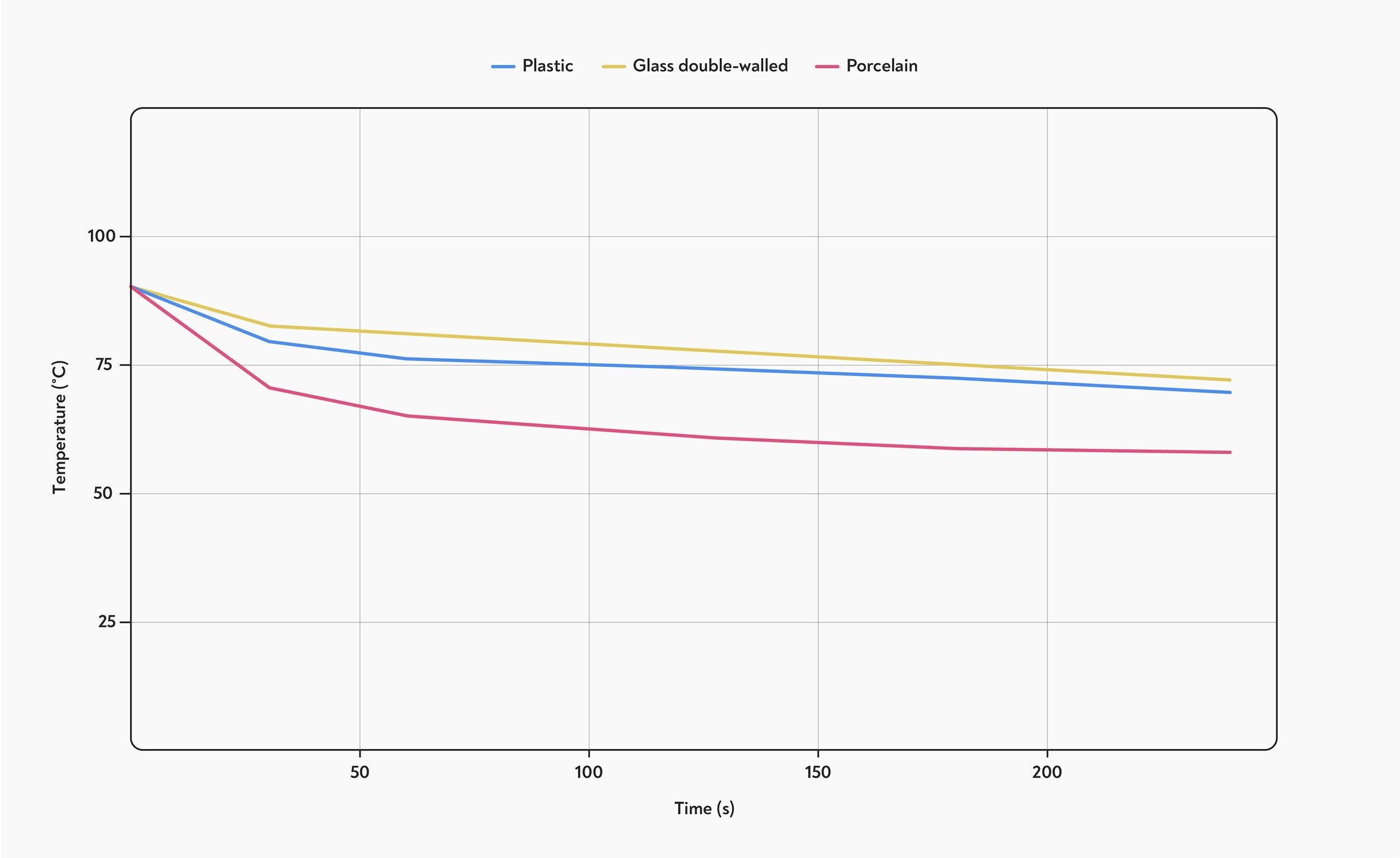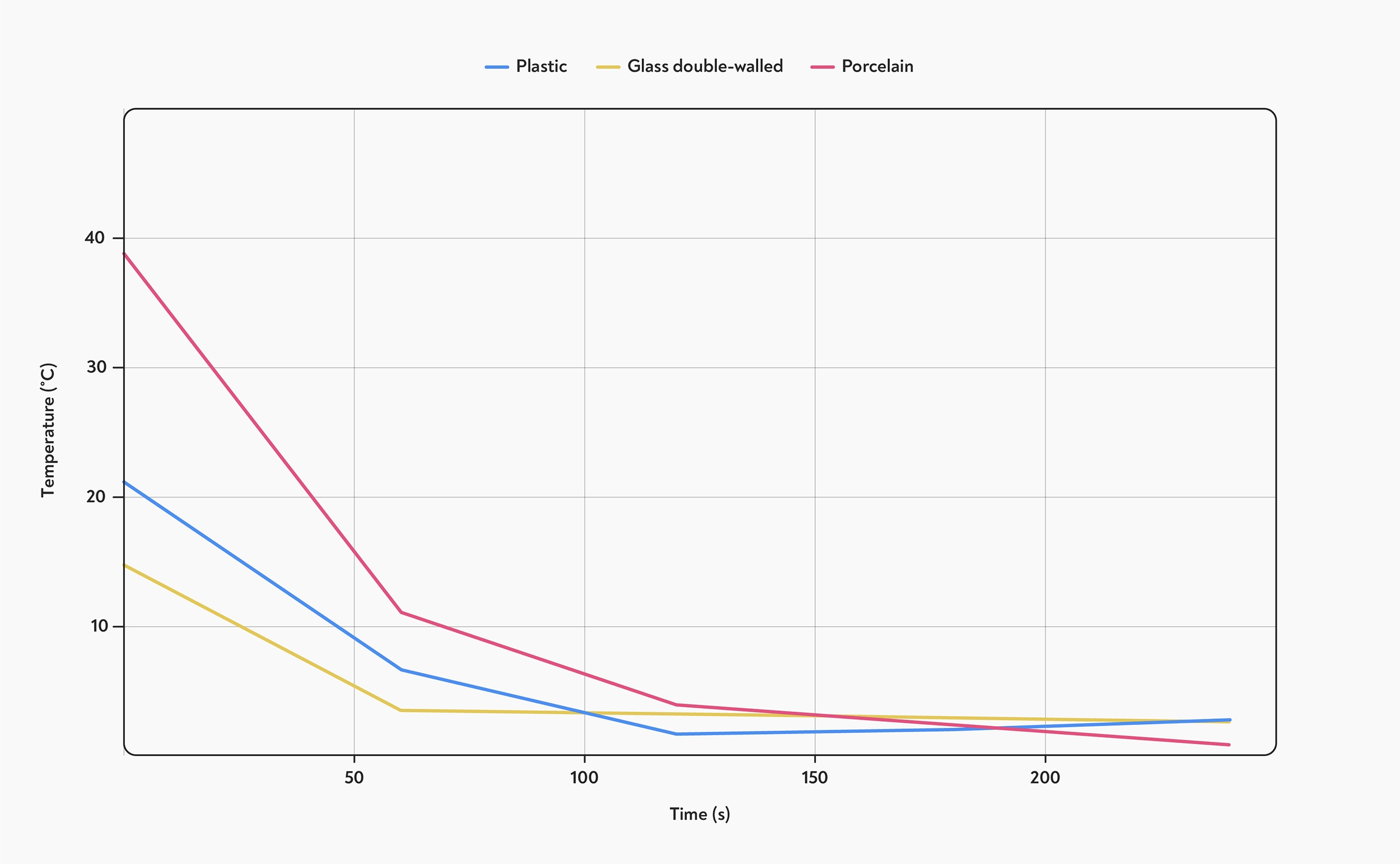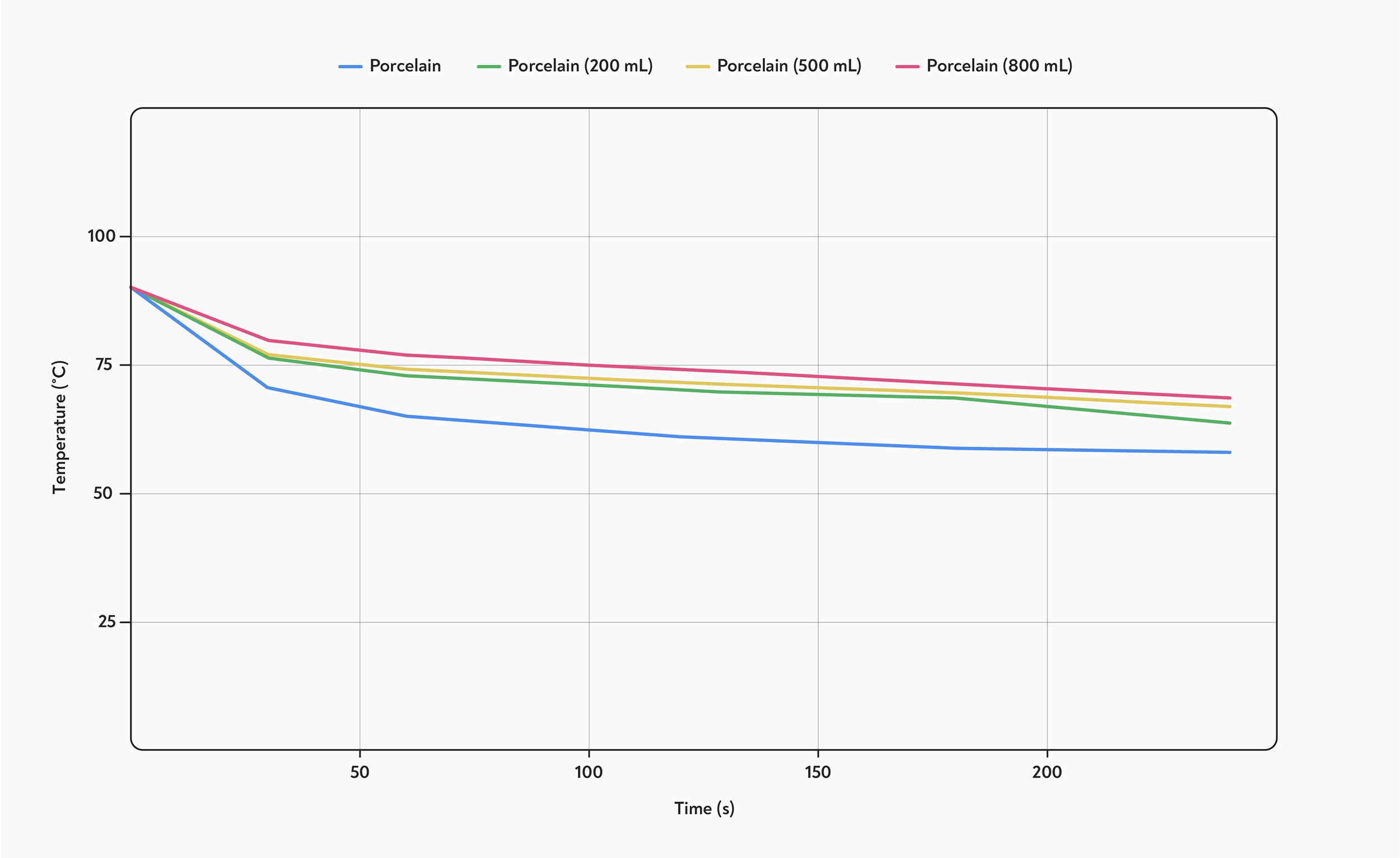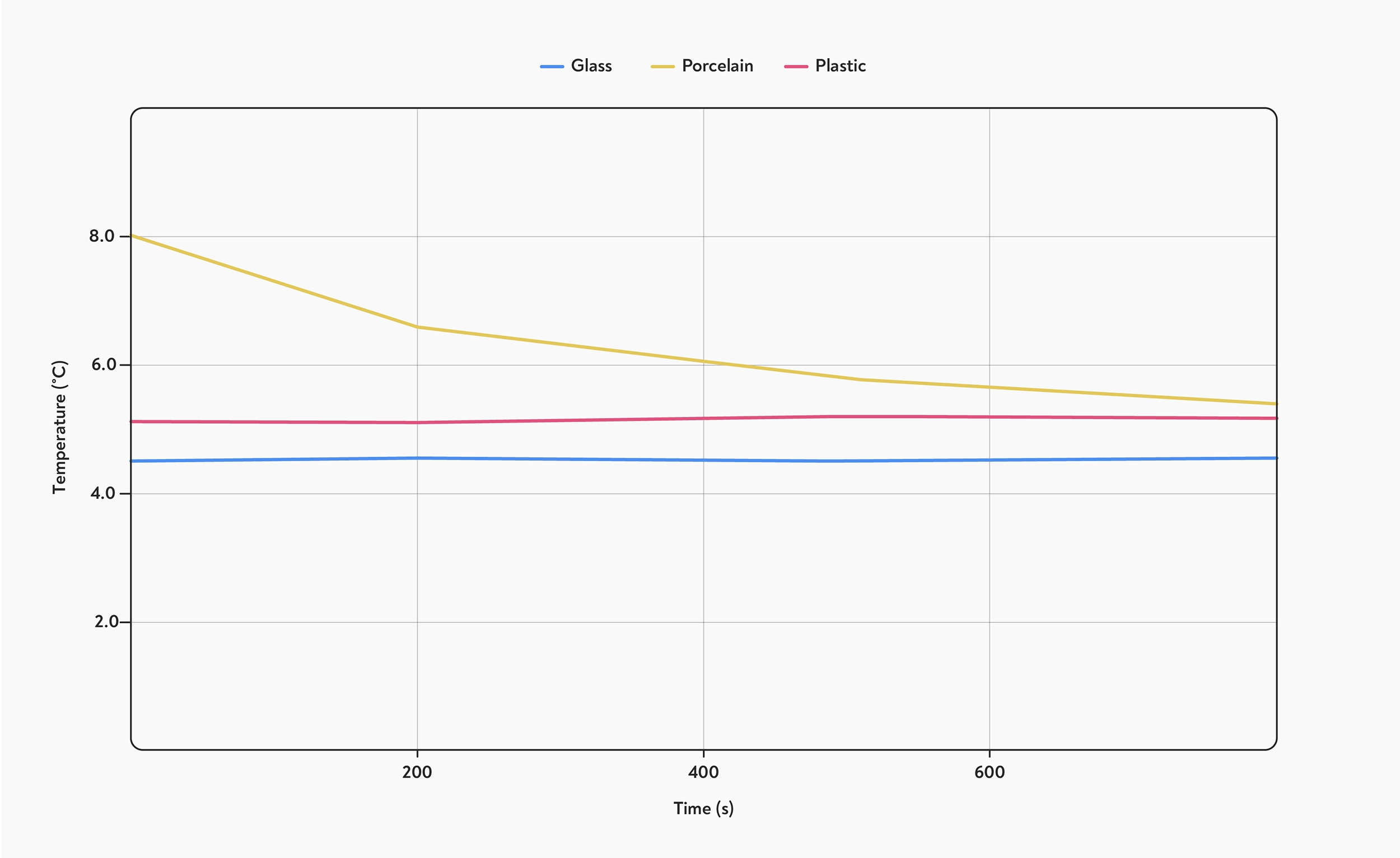The Power of the Double-Wall Brewer
When we’re brewing filter coffee, our preference at BH is to use filter cones that lose as little heat as possible. In most cases, that means plastic is best — but plastic comes with other disadvantages. Plastics such as polycarbonate can absorb flavour compounds (van Willige et al 2010), potentially minutely affecting the flavour of the coffee. What’s more, the surface of plastic cones can degrade over time, creating minute pits or cracks that could harbour stale coffee flavours (this is precisely why we use inert HDPE for our cupping bowls).
Glass, on the other hand, is relatively inert, and keeps its smooth surface as long as it is not chipped or scratched. This is why glass is used for laboratory equipment, and makes it a good choice for coffee equipment too. The only disadvantages are that it is relatively fragile, and that it is less good at keeping heat in the brew.
Brewista Tornado, a double walled glass brewer
Double-walled designs promise to overcome the second problem, by using the insulating power of air. Air is an excellent insulator — just think of the way double glazing works. But does a double-walled design make enough difference to overcome glass’s natural disadvantages? We tested out the Tornado, a new double-wall glass brewer from Brewista, and to our surprise, found that it massively outperforms our acrylic plastic V60 in keeping the heat inside the brew.
The Protocol
Double wall designs have been on the market for some years, but the new design by Brewista takes the idea a step further by creating a fully-sealed double wall for the first time. The Tornado is very similar in shape and size to a Hario V60 02, so we set up a comparison between the Tornado and the classic V60, in porcelain and plastic.
To find out how much heat each cone pulls out of the water, we set up a thermocouple with the probe in the middle of the exit hole of the brewer. We sealed the base of the cone to prevent water flowing out, poured in 200ml of water at 90°C, and recorded how the temperature changed over time.
We started the experiment with the cone at room temperature each time, but then also checked the effect of preheating the cone with different amounts of water — pouring boiling water through the cone to pre-heat as you would before starting a brew, before immediately sealing the cone and starting the experiment. We ran each experiment in triplicate.
Material Choices
It was immediately clear that the porcelain was pulling a lot of heat out of the brewing water. By the time of the first measurement 30 seconds in, the water temperature had dropped a whopping 20 degrees. The plastic brewer, meanwhile, was absorbing a lot less heat, which is what we would expect to see as plastic is about 20 times less conductive than porcelain. The surprise, however, was that the double-walled glass brewer was doing even better — despite the fact that glass is more conductive, and has a higher heat capacity, the extra insulation provided by the double wall prevented heat from escaping the brewing water right from the very start of the brew.
 Temperature changes in the three types of filter cone over time. The reading at time 0 is the temperature of the water immediately before pouring it into the cone. The double-walled glass is most effective at keeping the heat in.
Temperature changes in the three types of filter cone over time. The reading at time 0 is the temperature of the water immediately before pouring it into the cone. The double-walled glass is most effective at keeping the heat in.
After the rapid initial drop in temperature, the rate of temperature loss decreased significantly for all three types. By the end of the experiment, the rate of temperature change was very similar between the three types of brewer. We assume the initial drop in temperature is the result of heat being absorbed by the cone itself. The slower drop in temperature later on in the experiment represents heat being lost by evaporation, and from the outside surface of the brewer.
Normally, the rate of heat loss is proportional to the temperature difference, so a cooler brewer should be losing heat less quickly. In the later part of the experiment, the temperature was considerably lower inside the porcelain cone — but the cone was still losing heat at a similar rate to the other brewers. Not only does it absorb more heat initially, it’s also more effective at shuttling that heat out into the atmosphere.
 The rate of heat loss in the three types of filter cone. All three types of cone absorb heat from the water most quickly in the first minute. Once the cones themselves are hot, the rate of heat loss slows down.
The rate of heat loss in the three types of filter cone. All three types of cone absorb heat from the water most quickly in the first minute. Once the cones themselves are hot, the rate of heat loss slows down.
Preheating is Cheating
To overcome the tendency of porcelain to pull heat out of the brewing water, most baristas preheat the cone slightly by pouring hot water over it before preparing the brew. To check the effectiveness of this, we tested preheating the cone with 200, 500, and 800 ml of boiling water. Even with the smallest, 200 ml pre-heat, the cone is probably hotter than it would be in a typical practical situation. Baristas rarely use that much water to preheat, and then after heating, the cone would have a brief moment to cool while the coffee is put in the cone and any other final preparations are made.
Preheating reduced the temperature loss in the porcelain cone. It has the strongest effect at the start of the brew, indicating that preheating the cone reduces the amount of heat absorbed by the cone itself, but doesn’t prevent the subsequent heat loss to the atmosphere.
 The effect of preheating the filter cone on heat loss. Using a larger volume of water to pre-heat the vessel progressively reduces the amount of heat lost to the brewer.
The effect of preheating the filter cone on heat loss. Using a larger volume of water to pre-heat the vessel progressively reduces the amount of heat lost to the brewer.
Preheating had little or no effect on the heat loss in the other two brewers, however. This suggests that the plastic and double-walled glass brewers absorb much less heat from the water, or absorb it more slowly in the preheating stage.
Although preheating the porcelain cone does reduce the amount of heat lost, it’s still nowhere near as effective as the other materials at keeping heat in. It takes more than 800mL of preheating water to make the porcelain cone nearly as effective as the other two brewers. Needless to say, throwing away 800 ml of boiling water is a huge waste — the energy used to heat water makes up by far the biggest part of the carbon footprint of a cup of coffee.
 The effect of preheating on the overall rate of heat loss. Preheating the porcelain cone reduces heat loss, but it would take more than 800 ml of boiling water to make the porcelain cone as effective as the plastic or double-walled glass cones.
The effect of preheating on the overall rate of heat loss. Preheating the porcelain cone reduces heat loss, but it would take more than 800 ml of boiling water to make the porcelain cone as effective as the plastic or double-walled glass cones.
Layering Up
When it comes to the debate between plastic vs glass vs ceramic, plastic is always expected to be the most stable choice. So then why are the double-walled glass cones so effective? The main reason is that air is such an effective insulator: the thermal conductivity of air is about 0.02 W/mK, compared to 0.2 W/mK for acrylic or polycarbonate plastics, and around 1 W/mK for glass. This explains the effectiveness of double glazing, polystyrene cups, and explains why you get told you need to ‘layer up’ your clothing in cold weather. An air gap prevents heat from reaching the atmosphere.
The results also suggest that in the case of the double-walled glass brewer, the cone itself is also not absorbing that much heat. Glass is more conductive than plastic, and the higher weight of a glass cone means that it typically has a higher heat capacity than a plastic one. In the case of the double-walled cone, however, it’s possible that the part of the glass in contact with the water is only a small part of the overall weight of the cone. A thin inner wall would help the cone absorb less heat from the water and make the most of the insulating layer of air.
These results don’t mean that a double-walled plastic cone wouldn’t be more effective still — but given how effective the Tornado is at keeping the heat in, the difference could be rather small. Given the other disadvantages that plastic has, perhaps glass is the smart choice after all.






“The Tornado is very similar in shape and size to a Hario V60 02” Is this correct? I explored getting one but did not get one because I wanted it to be same size as a V60 size 02, and I was told it is same size as the 01, not. Anyone confirm if it is close to 02? If so I will get one.
I recently picked up the 2-4 cup Tornado along with the Brewista #4 filters for it. Those filters are the same size as the V60-02 filters. I brew with 30 grams coffee and 500 grams water. I have never had an issue with the Tornado being able to handle the volume. My only issue is that I got used to closing the valve on the Hario Switch during the bloom phase. But the coffee I get from this is quite good.